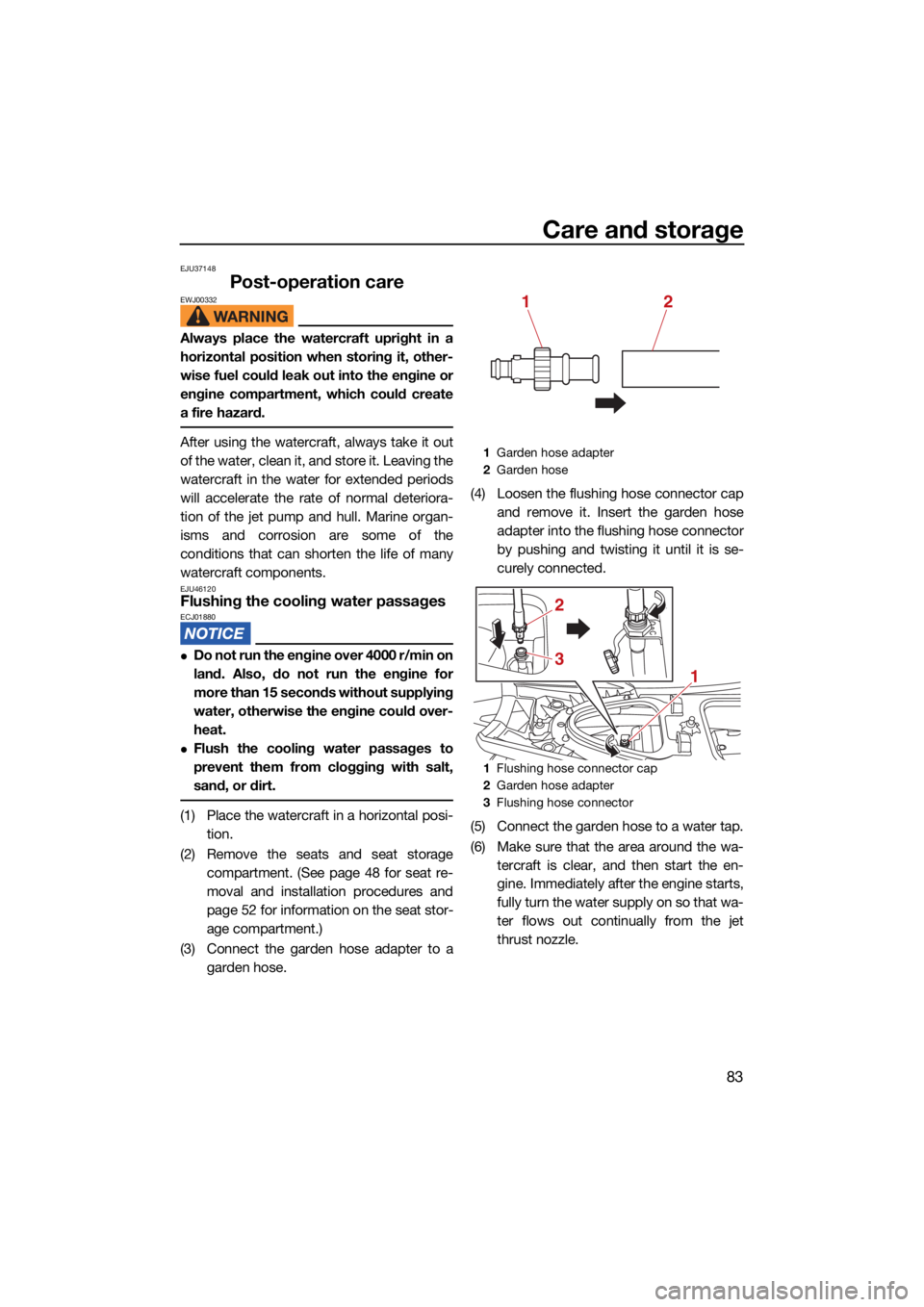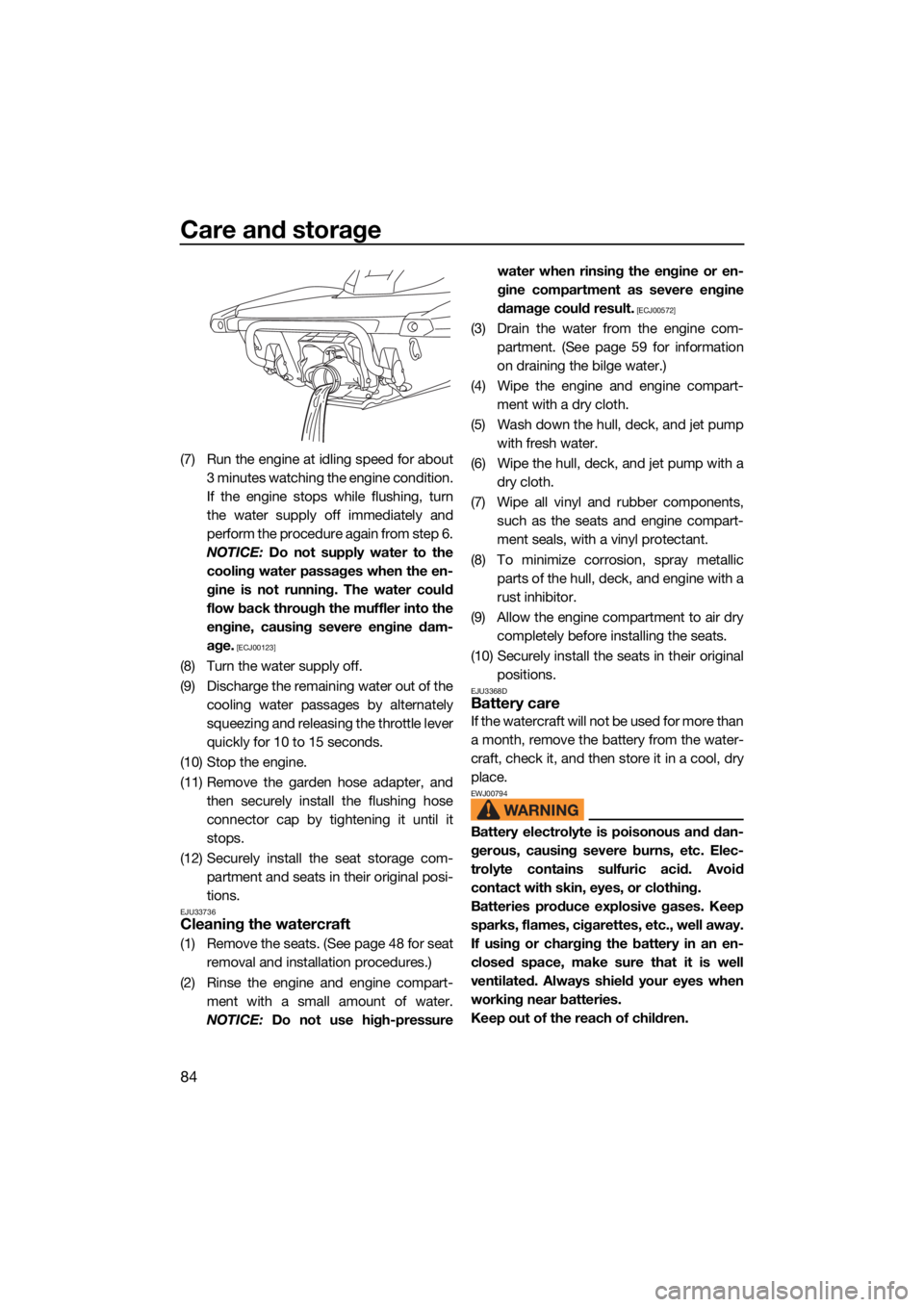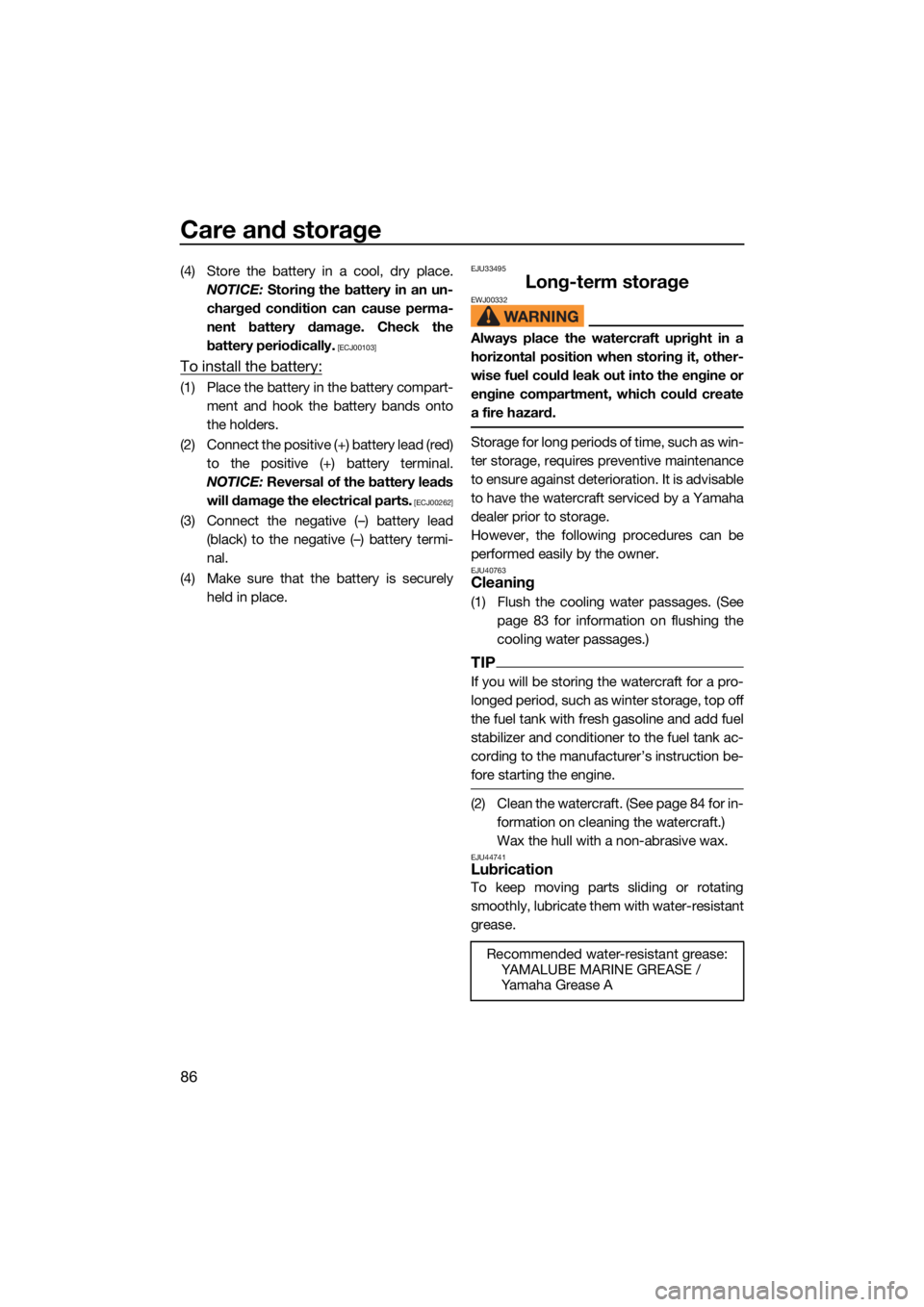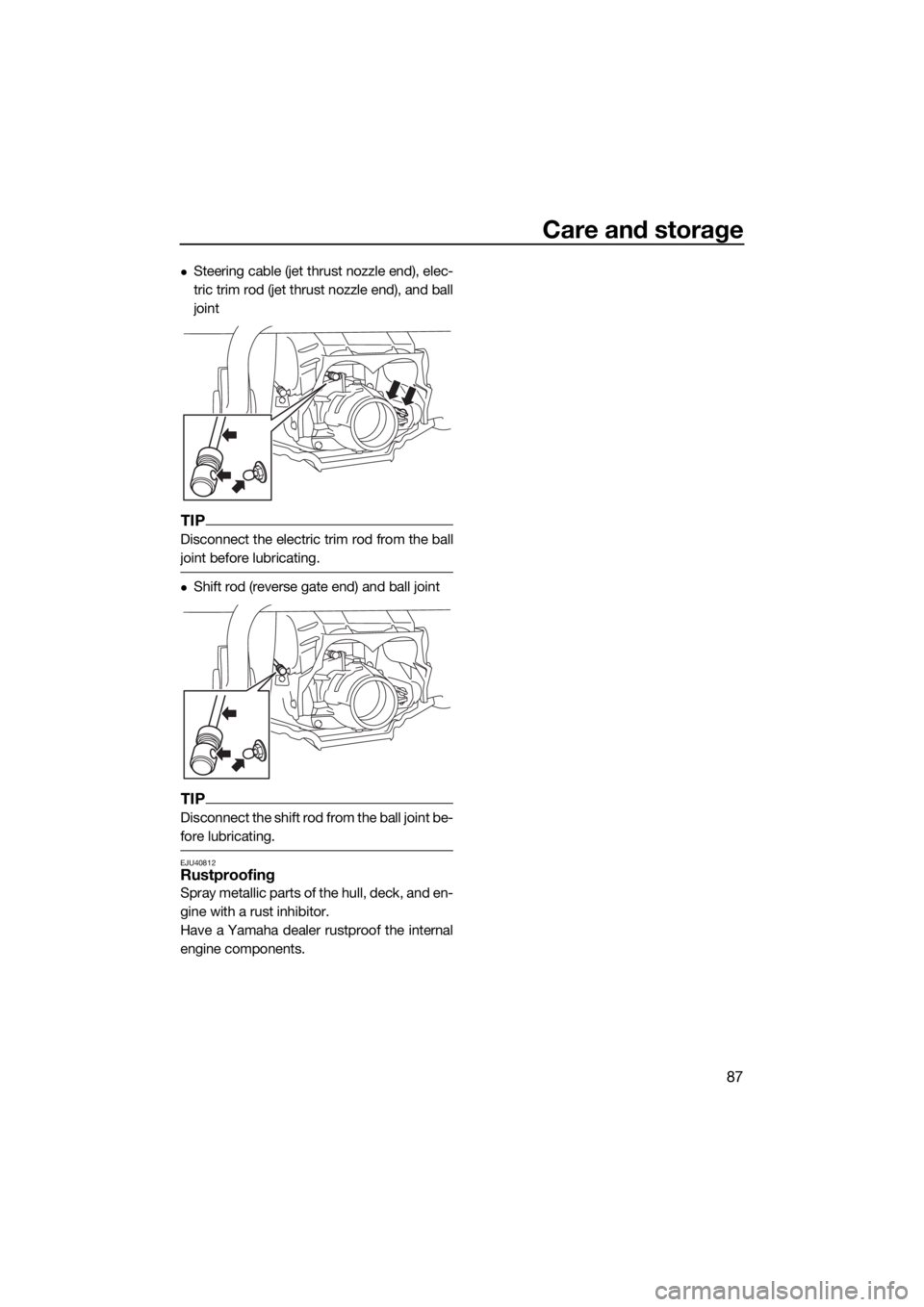YAMAHA GP1800R SVHO 2022 Owners Manual
Manufacturer: YAMAHA, Model Year: 2022, Model line: GP1800R SVHO, Model: YAMAHA GP1800R SVHO 2022Pages: 112, PDF Size: 4.91 MB
Page 91 of 112

Care and storage
83
EJU37148
Post-operation careEWJ00332
Always place the watercraft upright in a
horizontal position when storing it, other-
wise fuel could leak out into the engine or
engine compartment, which could create
a fire hazard.
After using the watercraft, always take it out
of the water, clean it, and store it. Leaving the
watercraft in the water for extended periods
will accelerate the rate of normal deteriora-
tion of the jet pump and hull. Marine organ-
isms and corrosion are some of the
conditions that can shorten the life of many
watercraft components.
EJU46120Flushing the cooling water passagesECJ01880
Do not run the engine over 4000 r/min on
land. Also, do not run the engine for
more than 15 seconds without supplying
water, otherwise the engine could over-
heat.
Flush the cooling water passages to
prevent them from clogging with salt,
sand, or dirt.
(1) Place the watercraft in a horizontal posi-tion.
(2) Remove the seats and seat storage compartment. (See page 48 for seat re-
moval and installation procedures and
page 52 for information on the seat stor-
age compartment.)
(3) Connect the garden hose adapter to a garden hose. (4) Loosen the flushing hose connector cap
and remove it. Insert the garden hose
adapter into the flushing hose connector
by pushing and twisting it until it is se-
curely connected.
(5) Connect the garden hose to a water tap.
(6) Make sure that the area around the wa- tercraft is clear, and then start the en-
gine. Immediately after the engine starts,
fully turn the water supply on so that wa-
ter flows out continually from the jet
thrust nozzle.
1Garden hose adapter
2 Garden hose
1 Flushing hose connector cap
2 Garden hose adapter
3 Flushing hose connector
12
1
3
2
UF4P72E0.book Page 83 Tuesday, August 24, 2021 3:18 PM
Page 92 of 112

Care and storage
84
(7) Run the engine at idling speed for about3 minutes watching the engine condition.
If the engine stops while flushing, turn
the water supply off immediately and
perform the procedure again from step 6.
NOTICE: Do not supply water to the
cooling water passages when the en-
gine is not running. The water could
flow back through the muffler into the
engine, causing severe engine dam-
age.
[ECJ00123]
(8) Turn the water supply off.
(9) Discharge the remaining water out of the cooling water passages by alternately
squeezing and releasing the throttle lever
quickly for 10 to 15 seconds.
(10) Stop the engine.
(11) Remove the garden hose adapter, and then securely install the flushing hose
connector cap by tightening it until it
stops.
(12) Securely install the seat storage com- partment and seats in their original posi-
tions.
EJU33736Cleaning the watercraft
(1) Remove the seats. (See page 48 for seatremoval and installation procedures.)
(2) Rinse the engine and engine compart- ment with a small amount of water.
NOTICE: Do not use high-pressure water when rinsing the engine or en-
gine compartment as severe engine
damage could result.
[ECJ00572]
(3) Drain the water from the engine com-
partment. (See page 59 for information
on draining the bilge water.)
(4) Wipe the engine and engine compart- ment with a dry cloth.
(5) Wash down the hull, deck, and jet pump with fresh water.
(6) Wipe the hull, deck, and jet pump with a dry cloth.
(7) Wipe all vinyl and rubber components, such as the seats and engine compart-
ment seals, with a vinyl protectant.
(8) To minimize corrosion, spray metallic parts of the hull, deck, and engine with a
rust inhibitor.
(9) Allow the engine compartment to air dry completely before installing the seats.
(10) Securely install the seats in their original positions.
EJU3368DBattery care
If the watercraft will not be used for more than
a month, remove the battery from the water-
craft, check it, and then store it in a cool, dry
place.
EWJ00794
Battery electrolyte is poisonous and dan-
gerous, causing severe burns, etc. Elec-
trolyte contains sulfuric acid. Avoid
contact with skin, eyes, or clothing.
Batteries produce explosive gases. Keep
sparks, flames, cigarettes, etc., well away.
If using or charging the battery in an en-
closed space, make sure that it is well
ventilated. Always shield your eyes when
working near batteries.
Keep out of the reach of children.
UF4P72E0.book Page 84 Tuesday, August 24, 2021 3:18 PM
Page 93 of 112

Care and storage
85
Antidotes
External: Flush with water.
Internal: Drink large quantities of water or
milk. Follow with milk of magnesia, beaten
egg, or vegetable oil. Call a physician im-
mediately.
Eyes: Flush with water for 15 minutes and
get prompt medical attention.
To remove the battery:
(1) Disconnect the negative (–) battery lead.
(2) Disconnect the positive (+) battery lead.
(3) Unhook the battery bands, and then re-move the battery from the watercraft.
Checking the battery
Make sure that the battery case is not dam-
aged.
Make sure that the battery terminals are
not corroded or damaged.
Checking the battery voltage and charging
the battery
It is recommended to have a Yamaha dealer
check the battery voltage and charge the bat-
tery. Have a Yamaha dealer charge the bat-
tery as soon as possible if it seems to have
discharged. Keep in mind that the battery
tends to discharge more quickly if the vehicle
is equipped with optional electrical accesso-
ries. NOTICE: To charge a VRLA (Valve Regulated Lead Acid) battery, a special
(constant-voltage) battery charger is re-
quired. Using a conventional battery char-
ger will damage the battery.
[ECJ02810]
Checking the battery bands
Make sure that the battery bands are not
damaged.
To store the battery:
(1) Clean the battery case using fresh water.
(2) If the battery terminals are dirty or cor-
roded, clean them using a wire brush.
(3) Apply water-resistant grease to the bat- tery terminals.
1Battery band
2 Negative (–) battery terminal: Black lead
3 Positive (+) battery terminal: Red lead
21
3
1Battery band
1 Battery terminal
Recommended water-resistant grease:
YAMALUBE MARINE
GREASE/Yamaha Grease A
1
1
UF4P72E0.book Page 85 Tuesday, August 24, 2021 3:18 PM
Page 94 of 112

Care and storage
86
(4) Store the battery in a cool, dry place.NOTICE: Storing the battery in an un-
charged condition can cause perma-
nent battery damage. Check the
battery periodically.
[ECJ00103]
To install the battery:
(1) Place the battery in the battery compart- ment and hook the battery bands onto
the holders.
(2) Connect the positive (+) battery lead (red) to the positive (+) battery terminal.
NOTICE: Reversal of the battery leads
will damage the electrical parts.
[ECJ00262]
(3) Connect the negative (–) battery lead (black) to the negative (–) battery termi-
nal.
(4) Make sure that the battery is securely held in place.
EJU33495
Long-term storageEWJ00332
Always place the watercraft upright in a
horizontal position when storing it, other-
wise fuel could leak out into the engine or
engine compartment, which could create
a fire hazard.
Storage for long periods of time, such as win-
ter storage, requires preventive maintenance
to ensure against deterioration. It is advisable
to have the watercraft serviced by a Yamaha
dealer prior to storage.
However, the following procedures can be
performed easily by the owner.
EJU40763Cleaning
(1) Flush the cooling water passages. (Seepage 83 for information on flushing the
cooling water passages.)
TIP
If you will be storing the watercraft for a pro-
longed period, such as winter storage, top off
the fuel tank with fresh gasoline and add fuel
stabilizer and conditioner to the fuel tank ac-
cording to the manufacturer’s instruction be-
fore starting the engine.
(2) Clean the watercraft. (See page 84 for in-formation on cleaning the watercraft.)
Wax the hull with a non-abrasive wax.
EJU44741Lubrication
To keep moving parts sliding or rotating
smoothly, lubricate them with water-resistant
grease.
Recommended water-resistant grease:YAMALUBE MARINE GREASE /
Ya m a h a G r e a s e A
UF4P72E0.book Page 86 Tuesday, August 24, 2021 3:18 PM
Page 95 of 112

Care and storage
87
Steering cable (jet thrust nozzle end), elec-
tric trim rod (jet thrust nozzle end), and ball
joint
TIP
Disconnect the electric trim rod from the ball
joint before lubricating.
Shift rod (reverse gate end) and ball joint
TIP
Disconnect the shift rod from the ball joint be-
fore lubricating.
EJU40812Rustproofing
Spray metallic parts of the hull, deck, and en-
gine with a rust inhibitor.
Have a Yamaha dealer rustproof the internal
engine components.
UF4P72E0.book Page 87 Tuesday, August 24, 2021 3:18 PM
Page 96 of 112

Maintenance
88
EJU3376A
Maintenance
Periodic checks and lubrication will keep
your watercraft in the safest and most effi-
cient condition possible. Therefore, make
sure to carry out the periodic maintenance.
Safety is an obligation of the watercraft own-
er. Proper maintenance must be carried out
to keep the exhaust emission and sound lev-
els within the regulated limits. The most im-
portant points of watercraft inspection and
lubrication are explained on the following
pages.
See a Yamaha dealer for genuine Yamaha re-
placement parts and optional accessories
designed for your watercraft.
Remember, failures that are the result of the
installation of parts or accessories which are
not qualitatively equivalent to genuine
Yamaha parts are not covered by the limited warranty.
Maintenance, replacement, or repair of
the emission control devices and system
may be performed by any marine SI engine
repair establishment or individual. War-
ranty repair, however, must be performed
at an authorized Yamaha marine dealer-
ship.
EWJ00312
Be sure to turn off the engine when you
perform maintenance unless otherwise
specified. If you are not familiar with ma-
chine servicing, this work should be done
by a Yamaha dealer or other qualified me-
chanic.
EJU40434Removing and installing the engine
cover
The engine cover is removable.
To remove the engine cover:
(1) Remove the seats. (See page 48 for seat removal and installation procedures.)
(2) Remove the engine cover screws.
(3) Slide the engine cover toward the stern, and then lower the rear side of the cover.
(4) Lift up the cover to remove it.
1 Engine cover screw
1 Engine cover
1
1
UF4P72E0.book Page 88 Tuesday, August 24, 2021 3:18 PM
Page 97 of 112

Maintenance
89
To install the engine cover:
When installing the engine cover, simply re-
verse the steps for removal.
UF4P72E0.book Page 89 Tuesday, August 24, 2021 3:18 PM
Page 98 of 112

Maintenance
90
EJU43103Periodic maintenance chart
The periodic maintenance chart gives general guidelines for periodic maintenance. Have a
Yamaha dealer perform the checks in the following chart. However, maintenance may need to be performed more frequently depending on your operating conditions. If you have any
questions, consult a Yamaha dealer.
This “ √” mark indicates items to be checked and serviced by a Yamaha dealer.
Item OperationInitial Thereafter every
Page
10 hours 50 hours
or 12
months *1 100
hours or 12
months *1 200
hours or 24
months *1
Fuel line Check fuel hoses and
clamps
√
—
Fuel filler cap/Wa-
ter separator Check O-rings for cracks
and deformation
√
—
Fuel tank Check installation and
straps
√
—
Water inlet strainer Check for clogs and dam-
age
√
—
Cooling water hos-
es Check for damage and
leakage, and check
clamps
√
—
Engine oil Replace √√ 92
Oil filter Replace √92
Intermediate hous-
ing Lubricate
√—
Spark plugs Check √√ —
Battery Check state of charge,
terminals and bands
√
—
Battery leads Check terminals √—
Steering master Check operation and for
looseness
√√
—
Steering cable Check exterior and con-
nections, and lubricate
√
—
Electric trim rod Check exterior and con-
nections, and lubricate
√
—
Shift rod and re-
verse gate Check exterior and con-
nections, and lubricate
√
—
Air filter element Check for damage and
dirt
√
—
Air intake hoses Check for damage, and
check clamps
√
—
Thr
ottle body Lubricate throttle valve √—
UF4P72E0.book Page 90 Tuesday, August 24, 2021 3:18 PM
Page 99 of 112

Maintenance
91
*1: Whichever comes first.
*2: Check every 200 hours.
Perform the pre-operation checks and post-operation checks before performing periodic
maintenance.
Exhaust systemCheck for exhaust leak-
age, and check hoses and
clamps √
—
Breather hose Check breather hose and
clamps
√
—
Impeller Check for bends, dam-
age, and foreign material
√
—
Drive shaft spline Check for damage and lu-
bricate splines
√
—
Jet pump bearings Check bearings and
grease condition
√
—
Jet thrust nozzle Check movement, and lu-
bricate
√
—
Jet vacuum bilge Check hoses for clogs
and damage, check
clamps, and clean bilge
strainer
√
—
Stern drain plugs Check O-rings √—
Anode Check for corrosion, and
clean
√
*2 —
Valve clearance Check and adjust √ *2 —
Rubber coupling Check for cracks, inden-
tations, looseness, and
noise √
—
Engine mount Check for damage and
peeling
√
—
Item Operation
Initial Thereafter every
Page
10 hours 50 hours
or 12
months *1 100
hours or 12
months *1 200
hours or 24
months *1
UF4P72E0.book Page 91 Tuesday, August 24, 2021 3:18 PM
Page 100 of 112

Maintenance
92
EJU36943Engine oil and oil filterEWJ00341
Engine oil is extremely hot immediately af-
ter the engine is turned off. Coming in con-
tact with or getting any engine oil on your
clothes could result in burns.
ECJ00992
Do not run the engine with too much or not
enough oil in the engine, otherwise the en-
gine could be damaged.
It is recommended to have a Yamaha dealer
change the engine oil and the engine oil filter.
However, if you choose to change the oil and
filter on your own, consult a Yamaha dealer.
UF4P72E0.book Page 92 Tuesday, August 24, 2021 3:18 PM